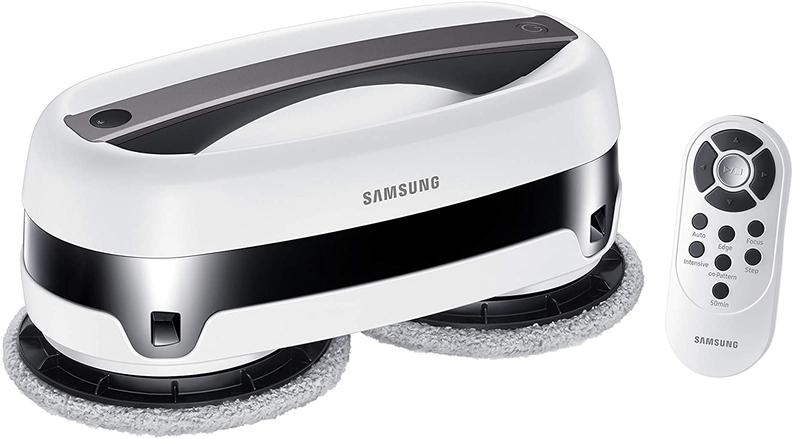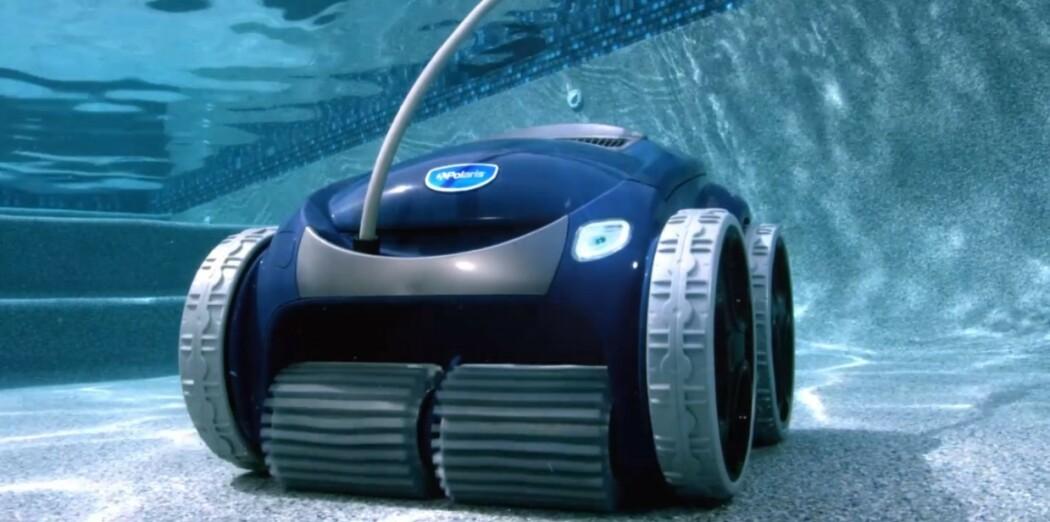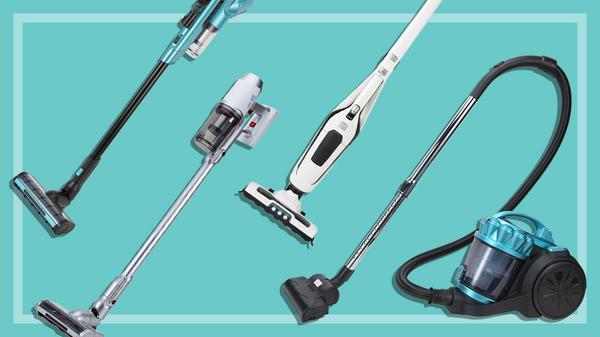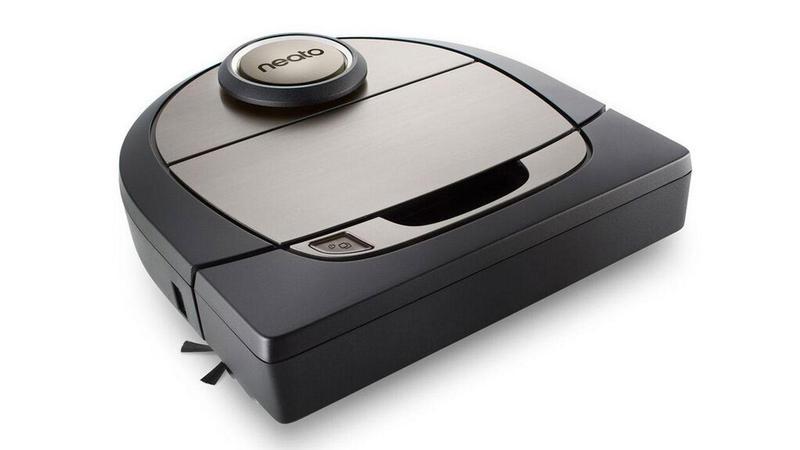Samsung Jetbot Mop
If you want clean floors but hate mopping, you might be the perfect candidate for a robot mop. And if you also happen to loathe cleaning the shower, tub, or any other similar surface, the $299 Samsung Jetbot Mop might be just the robot for you. Simply fill its tanks with water (and a bit of cleaning solution, if you want), pop on the mopping pads, use the included remote to select a cleaning mode, then sit back and relax as it roves around, maneuvering under chairs and around obstacles, while scrubbing your floors. Once they're shined to your satisfaction, you can head over to the bathroom, pick the lightweight 'bot up by its handle, and let its spinning pads bear the brunt of the effort in washing your walls. The Jetbot Mop doesn't offer some of the perks of pricier competitors, such as app or voice control, but if you're in search of an easy-to-use robot mop that can also clean your walls, it's worth a spot on your short list.
Jetbot Mop Design and Features
The Jetbot Mop has a compact design, measuring 15.0 by 9.3 by 9.0 inches (HWD). This allows it to easily clean under chairs and get into other tight spaces, and makes it a good option for small homes and apartments.
Similar to the $399.99 Bissell SpinWave Wet and Dry, the Jetbot Mop features two spinning pads on the bottom. The pads attach to tanks that you can fill up with just water, or with water and a water-based cleaning solution. You get four mop pads in the box: two green ones made of microfiber, and two gray ones made of mother yarn. Samsung says the microfiber pads offer "superior wiping performance" while mother yarn is ideal for cleaning spills and picking up dust in cracks.
The Jetbot Mop comes with a remote that lets you choose between eight different cleaning modes: Auto, Edge, Focus, Intensive, Pattern, Step, 50Min, and Manual. Unlike more expensive floor-cleaning robots that clean methodically, making straight lines to cover your floors, the Jetbot Mop ping-pongs in a random pattern in Auto mode. In Edge mode, it cleans around the borders of a room. Focus mode cleans in a spiral pattern, Intensive mode cleans diagonally in tight circles, Pattern mode creates a figure-8 cleaning pattern, and Step mode is more of a zig-zag. In 50Min mode, it cleans for 50 minutes, which is about how long it takes for the water tanks to run out. And finally, in Manual mode, you can control where the mop moves using arrows on the remote. Most of the time I just use Auto mode, but it's fun to experiment with the others.
The robot weighs just 6 pounds, and has a handle on top for easy transport. Aside from the aforementioned cleaning modes, the Jetbot Mop offers a unique Hand Mode feature I haven't seen on any rival models that lets you use the robot to manually scrub your walls.
Simple to Set Up and Operate
Because it lacks app and voice control support, the Jetbot Mop is a breeze to set up, even for beginners. You basically take it out of the box, plug it in to charge, then press the start button on the remote to send it on its way.
Unlike most floor-cleaning robots, the Jetbot Mop doesn't come with a docking station where it can automatically return for charging, though Samsung does give you a floor plate you can set it on when not in use. It comes with a power adapter, and you need to manually plug it in to charge every time it runs low on battery. I recommend plugging it in and fully charging it after every cleaning session, so it's always juiced up when you need to call it back into action.
While charging, the LED on the robot's Operation button (located on the handle) blinks yellow to indicate a low battery level, blue to indicate a medium battery level, and turns off when the battery is fully charged. In testing, it only took around 1.5 hours to reach a full charge.
When you're ready to clean, just grab two of the mopping pads, thoroughly wet them with clean water, ring them out, and attach them to the water tanks. Next, open the rubber cap on the water tank, fill it with water, close the cap, and attach it to the bottom of the robot (you'll hear a clicking sound when it's secured), then repeat with the other water tank.
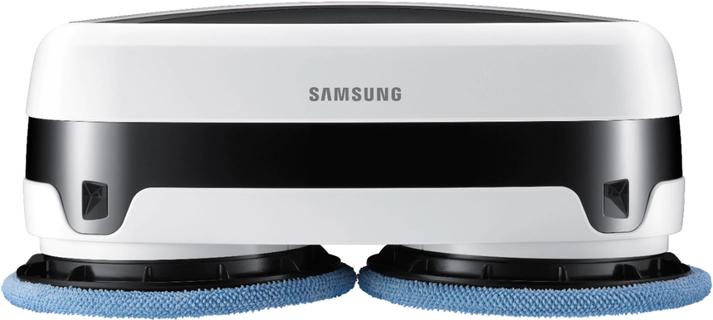
Next, press the Operation button for two seconds until you hear a beep and the light stays on, then use the remote to press start (which defaults to Auto mode) or use one of the other buttons to select your preferred cleaning mode.
The robot will sound an alarm after about 50 minutes and the LED will blink blue to indicate it's running low on water. When that happens, Samsung recommends you either recharge the robot, or change the mop pads, refill the water tank attachments, and send it back out to continue cleaning.
To enable Hand Mode, just lift the robot by its handle, press the Operation button twice and the mop pads will begin spinning, so you can scrub your walls. When you're done, press the Operation button once and the pads will stop spinning.
Small But Mighty
The Jetbot quickly and relatively quietly zips around as its dual spinning pads scrub your floors, leaving behind a film of water that dries within seconds. Samsung says it runs at 63dBA, which is about as loud as a normal conversation or background music, so it's pretty unobtrusive.
In terms of battery life, it cleaned for nearly two full hours in testing (109 minutes, excluding the time it took to refill the water tanks), exceeding Samsung's 100-minute estimate. About halfway through, the robot beeped and blinked blue, indicating it was out of water. I refilled the tanks, swapped the dirty mopping pads for fresh ones, and sent it back out to clean.
While cleaning, the robot never once got stuck, and easily traversed the boundary strip separating the tile in my kitchen from the laminate in my dining and living rooms. Samsung says the robot features smart sensors that prevent it from falling down the stairs, and help it automatically avoid carpeting when cleaning. In testing, however, it did sometimes roll onto area rugs and carpeting. When its battery is fully drained, the robot stops in place and its LED shines yellow.
The dark color of the mother yarn mop pads doesn't really show dirt, so when the Jetbot was done cleaning I wet them a bit, wrung them out, and the water that came off was very cloudy, indicating the robot did its job. The green pads, meanwhile, were visibly dirty after mopping my floors with just water. Upon inspecting its work, I noted that my tile kitchen floor looked and felt a lot cleaner, with no streaks in sight. Granted, the olive-gray tile on the floor easily hides smudges, but the Jetbot Mop got it to shine with just water.
I was less impressed by the look of the laminate floors in my dining and living rooms, which had visible streaks, likely due to the robot's random cleaning pattern and the fact that it was only mopping with water at the time, not a cleaning solution. The laminate did look better, but nowhere near as sparkly as it gets after I run the Bissell SpinWave Wet and Dry, which travels in straight lines and comes with a cleaning solution you can use when mopping.
In the Jetbot Mop's user manual, it clearly states that the robot should be used with "water only." However, on its website, Samsung says you can fill the robot with a "water-based floor cleaning solution."
So for its second test run, I decided to add a tiny bit of floor cleaning solution to the Jetbot Mop's tanks to see what would happen. I had a bottle of dollar-store floor cleaner under my sink, so I added about a tablespoon to each tank, filled them up the rest of the way with water, and ran the robot again. I'm happy to report that the robot worked just fine with a small amount of cleaning solution in the tank and my floors looked a lot shinier afterward.
An Affordable Robot for Cleaner Floors and Walls
The $299 Samsung Jetbot Mop can help you check two of the most tedious cleaning tasks off of your to-do list: mopping your floors and washing your shower or bathtub. Thanks to the two spinning pads on the bottom and a handle on top, this versatile robot can scrub the gunk off of tile, vinyl, laminate, or hardwood floors with little help on your part, and does double duty as a handheld cleaning tool for washing your walls. It has a compact design that allows it to autonomously maneuver around obstacles with ease, and it's short enough that it won't get stuck under furniture. It works quickly, and when used with a bit of cleaning solution truly makes your floors shine.
In this price range, it's also worth checking out the $249.99 iLife W400 Floor Washing Robot. It features separate clean and dirty water tanks and a rubber scraper to wipe off residue and remove smudges, though it's slower than the Jetbot and sometimes has difficulty switching between floor types. The iRobot Braava 380t is the same price as the Jetbot Mop and works well, but it's much older (we first reviewed it in 2012) and requires a battery-powered NorthStar Navigation Cube for multi-room cleaning.
If you're willing to spend more, the $399.99 Bissell SpinWave Wet and Dry is our Editors' Choice award winner. It doesn't work as a handheld cleaning tool, but it doubles as a robot vacuum that can clean your carpeting. It can also be controlled from your phone, automatically docks when finished cleaning, supports scheduling, and moves in straight lines for fewer smudges, making for an even more hands-off cleaning experience.
